
Augmenting Tradition With Technology to Push the Boundaries of Precision
Jewelry and technology has always gone hand-in-hand. The earliest metallurgists were more artists than scientists, but they couldn’t have worked their magic without the aid of the high-tech devices of their day: the furnace and the bellows. The progress of the jeweler’s craft through the ages is a story of technological advancement, with new technology arising to serve human imagination.
When we think about technology, we tend to think about “high technology”: electronics, computers, robots, and the like. But tools that seem low-tech to us were once the state of the art. As new technology and techniques are developed, some are adopted and become industry standards, and some fall by the wayside. It’s that balance that we want to achieve: the balance of traditional and high-tech, combining a mastery of hand-crafted artistry with the technological expertise that lets us push our vision into new frontiers.
Technology That Helps Bring the Artist’s Vision to Life
If we covered all the ways that advancements in tools, technology, technique, and machinery have changed the art of jewelry-making, this blog post would be a book. Here are just two examples of new technological developments allowing us to do new and creative things with metal.
At the end of the Stone Age, about 8000 years ago, artisans in the Near East discovered that they could melt down copper and work it into objects, typically tools or decorative and ceremonial objects. Furnaces would have to be heated to over 1000°C (about 2000°F) to separate the copper ore from slag, which required another technological innovation: the bellows. Once the copper was separated from the slag, it could then be hammered into shape. This technology formed the basis that the art and science of metalworking would develop from over millennia.
The next few thousand years brought new techniques for building hotter and hotter fires. It wasn’t until the mid-19th century that platinum could be melted down. Before then, platinum didn’t have much use. The oxyhydrogen blowpipe was the first torch hot enough to heat platinum to its melting point of over 1700°C (about 3000°F). This technological advancement ushered in the golden age of platinum jewelry, spanning the Art Nouveau and Art Deco movements of the late 19th and early 20th centuries.
In between these two advancements were thousands of others that gave metalsmiths and stonecutters the ability to create the jewels that define civilizations, from the ancient Egyptians to the Mughals of 16th century India.
Computer-Aided Design: Enabling Greater Precision and Creativity
Computer-Aided Design (CAD) is one of the many technologies that has allowed us to take our creativity and precision to new levels. One of the drawbacks of sketching out jewelry designs on a sheet of paper is that you’re working in 2D. It’s not impossible, but it’s harder to know if a particular design is going to actually work. You might end up with a pretty drawing, but not a functional piece of jewelry. CAD lets you design in three dimensions, rotating the design, zooming in on details, and creating an amazingly precise design.
On the customer’s end, you can see the value of a photorealistic rendering in the Design Center. Jewelry is three-dimensional. It has to look beautiful no matter what direction you’re seeing it from. Getting that instant feedback on your design in the form of a photorealistic 3D image that you can rotate and zoom in on is so much more useful than just seeing a 2D image.
Part of the jeweler’s skill is in deciding the best tool for the job, a traditional one or a high-tech one. A skilled jeweler has a deep familiarity with the traditional, fundamental techniques of the artform. Without this knowledge, we wouldn’t be able to get the most out of the technology we use. Combining the best modern technology with a mastery of traditional techniques is how we bring you the meticulously crafted pieces found in our collections.